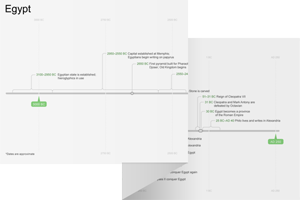1:1–7 The opening verses of the book of Exodus provide the narrative backdrop for the events to follow in Exod 1–19. The descendants of Jacob (or Israel) have been in Egypt for generations. By the time they leave Egypt, they will have spent 430 years there (12:40–41). Since the date of their arrival in Egypt is uncertain, this chronological clue only provides a rough approximation. The exodus most likely occurred sometime in the Late Bronze Age (1550–1200 bc). The two best options for the narrative’s historical setting are mid-15th century bc and early 13th century bc. |
1:1 these are the names of Although most translations do not include it, the book of Exodus begins with the Hebrew conjunction usually translated “and.” This connects Exodus with the events that concluded Genesis.
conjunction usually translated “and.” This connects Exodus with the events that concluded Genesis.
the sons of Israel See Gen 29:31–30:24; 46:5–27.
who came to Egypt This opening verse indicates that the narrative of Exodus is a continuation of the story of Abraham’s descendants that began in Gen 12–50. By the end of Genesis, Abraham’s grandson Jacob (also known as Israel) has moved his family to Egypt due to famine (Gen 45:5–8). The story of Exodus picks up many years later with the descendants of Israel living under Egyptian rule.
1:5 seventy individuals See note on Gen 46:26–27.
in Egypt See Gen 37.
1:7 land Goshen; see note on Gen 45:10; 46:28–34; 47:1–6.
1:8 a new king A new pharaoh.
did not know Joseph Because centuries have passed since the time of Joseph (compare note on Exod 1:1), the new pharaoh may not have known of him. Alternately, he may have known about Joseph, but had no regard for his people or his past service to Egypt. The new pharaoh considered the growing number of Israelites a potential threat (v. 9).
The new pharaoh considered the growing number of Israelites a potential threat (v. 9).
1:10 we must deal shrewdly with them Pharaoh unwittingly becomes an obstacle to the covenant promises God gave to Israel (see Gen 12:1–3; 15:1–6).
gave to Israel (see Gen 12:1–3; 15:1–6).
1:11 to oppress them with their forced labor The servitude described is not domestic slavery, as was the case with Joseph (Gen 39:1–5). The terms here describe harsh oppression. The Israelites were tasked with making bricks for building projects and laboring in the fields (see Exod 1:14; compare 5:7–19).
storage cities The Israelites may not have been the actual builders of these cities; v. 14 (compare 5:7–19) shows that they were responsible for producing the building materials. However, some Israelites may have participated in work gangs on building projects.
Pharaoh The identity of this pharaoh is unknown. The biblical accounts do not identify any pharaohs by name until a much later period, so the pharaohs involved in the events of Genesis and Exodus are unknown. See note on Gen 40:2.
Pithom and Rameses These cities, well attested in Egyptian sources, are in the region of Goshen (see note on Gen 47:11).
1:12 they spread out God’s blessing on the Israelites is evident despite their oppression.
1:15 Hebrew midwives Despite there being thousands of Hebrew women (see Exod 1:7), the text names only two midwives. They might have been supervisors to other midwives, or they could be representative of the midwives of the time.
Hebrew See note on Gen 14:13. The precise meaning and derivation of “Hebrew” remains uncertain.
Shiphrah The Semitic root of Shiphrah means “beautiful.”
means “beautiful.”
Puah The Semitic root of Puah refers to a fragrant flower or blossom.
refers to a fragrant flower or blossom.
1:16 pairs of testicles In the ancient Near East, when giving birth women would kneel or squat on special stools.
you will put him to death Pharaoh targeted males because they can reproduce with many women—men often had more than one wife in the ancient Near East. Furthermore, since men can serve as soldiers, the Egyptians feared that the Israelites would become a rival military power (Exod 1:9).
1:17 had said to them In disobeying Pharaoh, the Hebrew midwives were motivated by their loyalty to Yahweh, and a sense of moral rightness derived from their faith in Yahweh. God rewarded the midwives for their actions (v. 21).
1:19 Egyptian women These Hebrew midwives (see v. 15) also served Egyptian women.
1:22 all his people Pharaoh’s instructions now extend beyond the midwives to all people living in Egypt under his authority. He commands that all male Hebrew infants be thrown into the Nile at birth.

|
About Faithlife Study BibleFaithlife Study Bible (FSB) is your guide to the ancient world of the Old and New Testaments, with study notes and articles that draw from a wide range of academic research. FSB helps you learn how to think about interpretation methods and issues so that you can gain a deeper understanding of the text. |
| Copyright |
Copyright 2012 Logos Bible Software. |
| Support Info | fsb |
 Loading…
Loading…



